 W
WThe Amu Darya is a major river in Central Asia and Afghanistan. Rising in the Pamir Mountains, north of the Hindu Kush, the Amu Darya is formed by the junction of the Vakhsh and Panj rivers, in the Tigrovaya Balka Nature Reserve on the border between Afghanistan and Tajikistan, and flows from there north-westwards into the southern remnants of the Aral Sea. In its upper course, the river forms part of Afghanistan's northern border with Tajikistan, Uzbekistan, and Turkmenistan. In ancient history, the river was regarded as the boundary of Greater Iran with "Turan", which roughly corresponded to present-day Central Asia.
 W
WThe Beas River is a river in north India. The river rises in the Himalayas in central Himachal Pradesh, India, and flows for some 470 kilometres (290 mi) to the Sutlej River in the Indian state of Punjab. Its total length is 470 kilometres (290 mi) and its drainage basin is 20,303 square kilometres (7,839 sq mi) large.
 W
WThe Betwa is a river in Northern India, and a tributary of the Yamuna. It rises in the Vindhya Range (Raisen) just north of Hoshangabad in Madhya Pradesh and flows north-east through Madhya Pradesh and Orchha to Uttar Pradesh. Nearly half of its course, which is not navigable, runs over the Malwa Plateau. The confluence of the Betwa and the Yamuna rivers is Hamirpur district in Uttar Pradesh, in the vicinity of Orchha.
 W
WThe Chenab River is a major river that flows in India and Pakistan, and is one of the 5 major rivers of the Punjab region. It rises in the upper Himalayas in the Lahaul and Spiti district of Himachal Pradesh state, India, and flows through the Jammu region of Jammu and Kashmir into the plains of Punjab, Pakistan, before flowing into the Indus River near the city of Uch Sharif. The waters of the Chenab were allocated to Pakistan under the terms of the Indus Waters Treaty.
 W
WThe Gandaki River, also known as the Narayani and the Gandak, is one of the major rivers in Nepal and a left bank tributary of the Ganges in India. Its total catchment area amounts to 46,300 km2 (17,900 sq mi), most of it in Nepal. In the Nepal Himalayas, it is notable for its deep canyon. The basin also contains three mountains over 8,000 m (26,000 ft), namely Dhaulagiri, Manaslu and Annapurna I. Dhaulagiri is the highest point of the Gandaki basin.
 W
WThe Ganges or Ganga is a trans-boundary river of Asia which flows through India and Bangladesh. The 2,704 km (1,680 mi) river originates from the Gangotri Glacier of western Himalayas in the Indian state of Uttarakhand, and flows south and east through the Gangetic Plain of India and Bangladesh, eventually emptying into the Bay of Bengal.
 W
WGhaghara, also called Karnali is a perennial trans-boundary river originating on the Tibetan Plateau near Lake Manasarovar. It cuts through the Himalayas in Nepal and joins the Sharda River at Brahmaghat in India. Together they form the Ghaghara River, a major left bank tributary of the Ganges. With a length of 507 kilometres (315 mi) it is the longest river in Nepal. The total length of Ghaghara River up to its confluence with the Ganges at Revelganj in Bihar is 1,080 kilometres (670 mi). It is the largest tributary of the Ganges by volume and the second longest tributary of the Ganges by length after Yamuna.
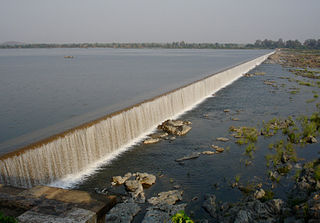 W
WThe Godavari is India's second longest river after the Ganga. Its source is in Triambakeshwar, Maharashtra. It flows east for 1,465 kilometres (910 mi), draining the states of Maharashtra (48.6%), Telangana (18.8%), Andhra Pradesh (4.5%), Chhattisgarh (10.9%) and Odisha (5.7%). The river ultimately empties into the Bay of Bengal through an extensive network of tributaries. Measuring up to 312,812 km2 (120,777 sq mi), it forms one of the largest river basins in the Indian subcontinent, with only the Ganga and Indus rivers having a larger drainage basin. In terms of length, catchment area and discharge, the Godavari is the largest in peninsular India, and had been dubbed as the Dakshin Ganga.
 W
WThe Gomti, Gumti or Gomati River is a tributary of the Ganges. According to Hindu beliefs, the river is the daughter of Rishi Vashist and bathing in the Gomti on Ekadashi can wash away sins. According to Bhagavata Purana one of Hinduism's major religious works, the Gomti is one of India's transcendental rivers. The rare Gomti Chakra is found there.
 W
WThe Gorai-Madhumati River is one of the longest rivers in Bangladesh and a distributary of the Ganges. In the upper reaches it is called the Gorai, and the name changes to Madhumati. Madhumati continuous stream through Kushtia, Jessore, Rajbari, Faridpur, Khulna, Pirojpur and Barguna districts in Bangladesh.
 W
WThe Indus River is one of the main rivers of the Indo-Gangetic Plain in the Indian subcontinent. It flows through China, India, and Pakistan. Originating in the Tibetan Plateau in the vicinity of Lake Manasarovar, the river runs a course through the Ladakh region of India towards Gilgit-Baltistan, and then flows in a southerly direction along the entire length of Pakistan to merge into the Arabian Sea near the port city of Karachi in Sindh. The Indus is the longest river of Pakistan.
 W
WThe Jhelum River is a river in northern India and eastern Pakistan. It is the westernmost of the five rivers of the Punjab region, and passes through the Kashmir Valley. It is a tributary of the Chenab River and has a total length of about 725 kilometres (450 mi).
 W
WThe Kabul River, the classical Cophen, is a 700-kilometre-long (430 mi) river that emerges in Maidan Wardak Province in the Sanglakh Range of the Hindu Kush mountains in Afghanistan, and is separated from the watershed of the Helmand River by the Unai Pass. The Kabul River empties into the Indus River near Attock, Pakistan. It is the main river in eastern Afghanistan and the Khyber Pakhtunkhwa province of Pakistan.
 W
WKaveri is an Indian river flowing through the states of Karnataka and Tamil Nadu. The Kaveri river rises at Talakaveri in the Brahmagiri range in the Western Ghats, Kodagu district of the state of Karnataka, at an elevation of 1,341 m above mean sea level and flows for about 800 km before its outfall into the Bay of Bengal. It is the third largest river – after Godavari and Krishna – in South India and the largest in the State of Tamil Nadu, which, on its course, bisects the state into North and South. The Kaveri is sacred river to the people of South India and is worshipped as the Goddess Kaveriamma. The Kaveri is also one of the seven holy rivers of India.
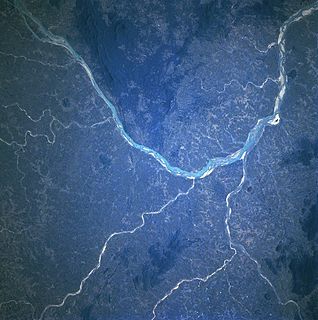 W
WThe Mahanadi is a major river in East Central India. It drains an area of around 141,600 square kilometres (54,700 sq mi) and has a total course of 858 kilometres (533 mi) Mahanadi is also known for the Hirakud Dam. The river flows through the states of Madhya Pradesh, Chhattisgarh and Odisha.
 W
WThe Mahisagar is a river in western India. It rises in Madhya Pradesh and, after flowing through the Vagad region of Rajasthan, enters Gujarat and flows into the Arabian Sea. It is one of the relatively few west-flowing rivers in India, alongside the endorheic Luni River, the Sabarmati River, the Tapti River and the Narmada River. Most peninsular rivers in India flow eastward into the Bay of Bengal or northward into the Ganges River.
 W
WThe Mandakini River is a tributary of the Alaknanda river, located in the Indian state of Uttarakhand. The river runs for approximately 81 kilometres (50 mi) between the Rudraprayag and Sonprayag areas and emerges from the Chorabari Glacier. The river merges with river Songanga at Sonprayag and flows past the Hindu temple Madhyamaheshwar at Ukhimath. At the end of its course it drains into the Alaknada river which eventually flows into the Ganges.
 W
WThe Narmada River, also called the Reva and previously also known as Narbada (Nerbudda). It is also known as "Life Line of Madhya Pradesh and Gujarat" for its huge contribution to the state of Madhya pradesh and Gujarat in many ways. Narmada rises from Amarkantak Plateau in Anuppur district Madhya Pradesh. It forms the traditional boundary between North India and South India and flows westwards over a length of 1,312 km (815.2 mi) before draining through the Gulf of Khambhat into the Arabian Sea, 30 km (18.6 mi) west of Bharuch city of Gujarat.
 W
WThe Phalgu or Falgu, a river that flows past Gaya, India in the Indian state of Bihar, is a sacred river for Hindus and Buddhists. Lord Vishnu's Temple Vishnupad Mandir is situated on the bank of Phalgu river also called Niranjana river.
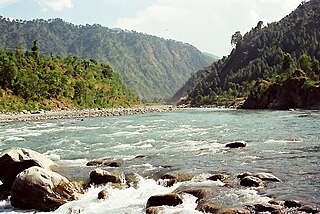 W
WThe Ravi River is a transboundary river crossing northwestern India and eastern Pakistan. It is one of six rivers of the Indus System in Punjab region.
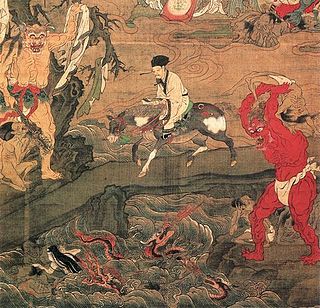 W
WThe Sanzu-no-Kawa , is a mythological river in Japanese Buddhist tradition similar to the Hindu concept of the Vaitarna and Greek concept of the Styx.
 W
WThe Sarasvati River is one of the rivers mentioned in the Rig Veda and later Vedic and post-Vedic texts. It plays an important role in the Vedic religion, appearing in all but the fourth book of the Rigveda.
 W
WThe Sutlej River is the longest of the five rivers that flow through the historic crossroads region of Punjab in northern India and Pakistan. The Sutlej River is also known as Satadree. It is the easternmost tributary of the Indus River.The bhakra dam is built around the river Sutlej to provide irrigation and other facilities to the nearby areas.
 W
WThe Swat River is a perennial river in the northern region of Khyber-Pakhtunkhwa Province, Pakistan. The river commences in the Kalam Valley of Swat Kohistan with the confluence of two main tributaries Ushu and Utrar and runs downstream in a narrow gorge up to Baghdheri.
 W
WThe Thamirabarani or Tamraparni or Porunai is a perennial river that originates from the Agastyarkoodam peak of Pothigai hills of the Western Ghats, above Papanasam in the Ambasamudram taluk. It flows through Tirunelveli and Thoothukudi districts of the Tamil Nadu state of southern India into the Gulf of Mannar. It was called the Tamraparni River in the pre-classical period, a name it lent to the island of Sri Lanka. The old Tamil name of the river is Porunai. From the source to sea, the river is about 128 kilometres (80 mi) long and is the only perennial river in Tamil Nadu. This river flows towards north direction initially. However, it changes to east direction later.
 W
WVaitarna or Vaitarani (Vaitaraṇî) river, as mentioned in the Garuda Purana and various other Hindu religious texts, lies between the earth and the infernal Naraka, the realm of Yama, Hindu god of death, and is believed to purify one's sins. Furthermore, while the righteous see it filled with nectar-like water, the sinful see it filled with blood. Sinful souls are supposed to cross this river after death. God Krishna explained soul satyanand Kumar According to the Garuda Purana, this river falls on the path leading to the Southern Gate of the city of Yama. It is also mentioned that only the sinful souls come via the southern gate.
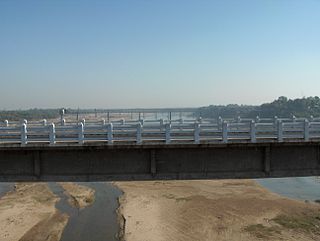 W
WOriginating from Pavagadh in the Panchmahal District of Gujarat, the Vishwamitri River flows mainly through the west of the city of Vadodara. The name of this river is said to have been derived from the name of the great saint Vishwamitra. Two other tributaries namely Dhadhar and Khanpur merge into it before it amalgamates with the Gulf of Khambhat. Human settlement dating back to 1000 B.C has been found on the bank of river Vishwamitri which ascertains the existence of Stone Age Era. Also in the beginning of the Christian era, a small township was developed on a mound on the banks of this river which later came to be known as Ankotakka while the mound is popular as Dhantekri. The Vishwamitri River was key to the settlement of Vadodara.
 W
WWest Rapti drains Rapti Zone in Mid-Western Region, Nepal, then Awadh and Purvanchal regions of Uttar Pradesh state, India before joining the Ghaghara—a major left bank tributary of the Ganges known as the Karnali inside Nepal.
 W
WThe Yamuna is the second-largest tributary river of the Ganga and the longest tributary in India. Originating from the Yamunotri Glacier at a height of 6,387 metres (20,955 ft) on the southwestern slopes of Banderpooch peaks of the Lower Himalaya in Uttarakhand, it travels a total length of 1,376 kilometres (855 mi) and has a drainage system of 366,223 square kilometres (141,399 sq mi), 40.2% of the entire Ganga Basin. It merges with the Ganga at Triveni Sangam, Prayagraj, which is a site of the Kumbh Mela, a Hindu festival held every 12 years.